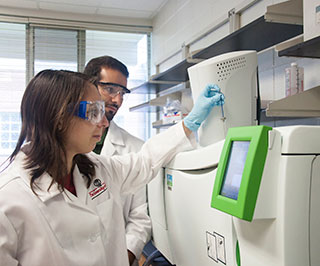 Image credit: UGA College of Agricultural & Environmental Sciences/flickr.com
Image credit: UGA College of Agricultural & Environmental Sciences/flickr.com
A study led by the Scripps Research Institute (TSRI) suggests that gas chromatography-mass spectrometry (GC-MS) through heating causes small molecules to change and even disappear. However, the provocative findings have drawn criticism from other scientists who have raised questions over the study’s methodology.
To determine how small molecules react to thermal stress, researchers heated a set of 64 small molecule standards, in addition to samples of human plasma metabolite extracts. They subjected the samples to three different temperatures (60°C, 100°C, and 250°C) at various exposure times, then analyzed them using liquid chromatography coupled to electrospray ionization mass spectrometry (LC/MS). The authors found that heating the molecules at 250°C led to significant changes.
“For example, over 40% of the molecular peaks were altered in the plasma metabolite analysis after heating (250°C, 300s) with a significant formation of degradation and transformation products. The analysis of 64 small molecule standards validated the temperature-induced changes observed on the plasma metabolites, where most of the small molecules degraded at elevated temperatures even after minimal exposure times (30s),” the article stated.
The study, led by Gary Siuzdak, PhD, senior director of TSRI’s Scripps Center for Metabolomics and professor of chemistry, molecular and computational biology, and published in the journal Analytical Chemistry, questioned whether GC-MS actually detected small molecules in the samples or merely thermal degradation products.
“The results were quite astounding—as this is a technology that has been used for decades,” said Siuzdak in an article TSRI published on the study results. He added that he wanted to publish these negative findings “for the students just getting started in their careers to report the limitation of such a ubiquitous technology.”
Not everyone agreed with the findings. According to one news report in Chemical & Engineering News (C&EN), some believe the study’s methods were flawed and that Analytical Chemistry erred in publishing this paper.
“I am unclear why a scientific journal would publish work that is such clear nonsense,” Oliver Fiehn, PhD, a professor at the University of California, Davis Department of Molecular and Cellular Biology & Genome Center, told C&EN. “The publication of this paper is, in my opinion, a major embarrassment for Analytical Chemistry. There was a peer review process involved, but perhaps not all peer reviewers understood the study design the Siuzdak group used.” Both C&EN and Analytical Chemistry are published by the American Chemical Society.
In Fiehn’s view, a fundamental flaw in the study was the analysis of trimethylsilyl-derivatized samples in a water-containing LC-MS solvent. “You cannot inject trimethylsilylated compounds in an aqueous solvent into an LC-MS system and expect that peaks survive…That’s why their MS spectra could not identify compounds: The authors destroyed them,” he told C&EN.
Other scientists, including Warwick Dunn BSc (Hons), PhD, a lecturer in metabolomics at the University of Birmingham, United Kingdom, faulted the study for heating dry, rather than wet, samples. “GC heats samples in a liquid solution for a few seconds during injection and then in the gas phase. Heat transfer in a solid can be expected to be higher and could therefore provide a higher level of degradation than in the gas phase,” he told C&EN.